Introduction:
The structure is like an animal’s skeleton. It holds the building together. All construction elements have structure to some extent since they hold themselves and other neighboring parts. Traditional architecture did not separate enclosing structures. To illustrate, consider a pyramid or Romanesque cathedral. Even though we could eliminate some, all the stones in the envelope are vital—all work to maintain stability. The difference between structure and envelope began in the 19th century with the introduction of new materials like steel and concrete. Today, most buildings have concrete, steel, or wood structures. Whether the structure is composed of brick, concrete blocks, or other load-bearing walls, it is evident which are structures and which are walls or partitions.
What is Structure in Construction?
In construction, “structure” refers to the arrangement and organization of various components and elements that make up a building or any other engineered construction. It encompasses the framework or skeleton of the construction that provides support, stability, and load-bearing capacity.
Structures are designed to withstand the forces and loads they may encounter, such as gravity, wind, seismic activity, and the weight of occupants or equipment. The primary purpose of a structure is to ensure the safety and integrity of the building, ensuring it can perform its intended function without failure.
Structural components typically include beams, columns, walls, floors, roofs, foundations, and other elements that contribute to the overall stability and strength of the construction. These components are often made from steel, concrete, wood, or a combination of materials.
Importance of Structures in Construction:
Structures play a crucial role in the field of construction. They provide stability, strength, and safety to buildings, bridges, dams, and other infrastructure projects. Here are some key reasons why structures are important in construction:
i) Safety: Structures ensure the safety of occupants and users. They are designed to withstand various forces, such as gravity, wind, earthquakes, and snow loads. A well-designed structure distributes these forces to the ground, preventing collapses or failures that could endanger people’s lives.
(ii) Stability: Structures provide stability to buildings and infrastructure. They resist lateral loads, such as wind or seismic forces, by transferring them to the ground through a combination of materials, shapes, and connections. Stability ensures that structures remain upright and secure under normal and extreme conditions.
(iii)Load-bearing capacity: Structures are responsible for carrying and distributing loads, such as the weight of the building itself, furniture, occupants, and environmental loads like snow or rain. The proper structural design ensures that the loads are safely transferred to the foundation without causing excessive deformation or failure.
(iv) Durability: Structures contribute to the longevity and durability of construction projects. By using appropriate materials, designing for environmental conditions, and considering maintenance requirements, structures can withstand the test of time, reducing the need for frequent repairs or replacements.
(v)Functionality: Structures enable the functionality and purpose of buildings and infrastructure. They support various architectural features like open spaces, large spans, and floor layouts. A well-designed structure optimizes the use of space, allowing for efficient and flexible utilization.
(vi) Aesthetic appeal: Structures also have an aesthetic aspect. Architectural structures, such as arches, domes, or unique building shapes, contribute to a construction project’s visual appeal and character. They can enhance the overall design and create memorable landmarks.
(vii) Cost-effectiveness: Proper structural design and analysis can lead to cost-effective construction. By optimizing material usage, reducing excessive reinforcement, and considering construction methods, structures can be designed efficiently, minimizing material waste and construction expenses.
(viii) Sustainability: Structures can contribute to sustainable construction practices. By incorporating environmentally friendly materials, energy-efficient designs, and considering life-cycle analysis, structures can minimize their environmental impact and promote sustainable development.
Types of Structures in Construction:
1. Load-Bearing Structure:
Load-bearing structures transfer loads from upper components to the foundation and ground. It supports and resists gravity, wind, earthquake activity, and other loads. Load-bearing constructions have columns, beams, walls, and foundations. These components uniformly and safely disperse loads to the earth. Load-bearing walls and columns distribute the weight from floors, roofs, and other loads to the foundation. Beams support columns and walls by distributing weight horizontally.
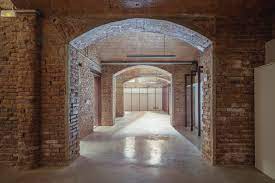
Fig1: Load Bearing Structure
Courtesy: structuralguide.com
Load-bearing structures are crucial for overall stability and integrity. The design and construction of load-bearing structures are based on engineering principles and considerations, considering the anticipated loads and forces the structure will experience during its lifetime. Structural engineers analyze the loads and design the load-bearing elements to withstand the expected stresses and forces without failure.
2. Framed Structures:
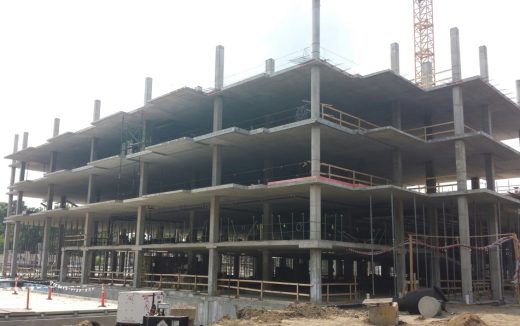
Fig2: Frame Structure
Courtesy: designingbuildings.co.uk
In construction, a frame structure refers to a structural system that uses a framework or skeleton composed of interconnected beams, columns, and other structural members to support the weight of a building or structure. Frame structures are used to construct buildings, bridges, and other large-scale infrastructure. The primary purpose of a frame structure is to provide strength, stability, and rigidity to the overall construction. Throughout the structural system, the framework distributes the loads acting on the structure, such as gravity loads (dead loads and live loads), wind forces, seismic forces, and other lateral loads.
Frame structures can be made from various materials, including steel, reinforced concrete, timber, or a combination. Each material offers advantages and is chosen based on cost, design requirements, structural integrity, and durability.
3. Truss Structure:
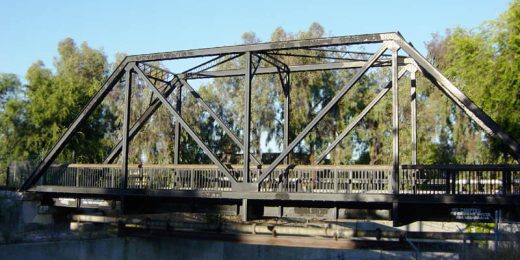
Fig3: Truss Structure
Courtesy: en.wikipedia.org
A truss structure is an engineering framework comprising straight members connected at joints. It is designed to carry loads efficiently and provide stability. Trusses are commonly used in various applications, including bridges, roofs, towers, and cranes. The basic components of a truss structure are the members and the joints. Members are typically made of steel or timber and can be either beam (horizontal members) or struts (diagonal or vertical members). Joints are the points where the members intersect and are connected, often using fasteners such as bolts, rivets, or welds.
Usually, axial forces, not twisting moments, carry loads in trusses. Trusses are lightweight and force-efficient. The strength and stiffness of truss components determine their load-bearing capacity. The structural analysis considers loads, support conditions, and material qualities while designing trusses. Pratt, Warren, Howe, and other trusses have different member and joint configurations.
4. Composite Structures:
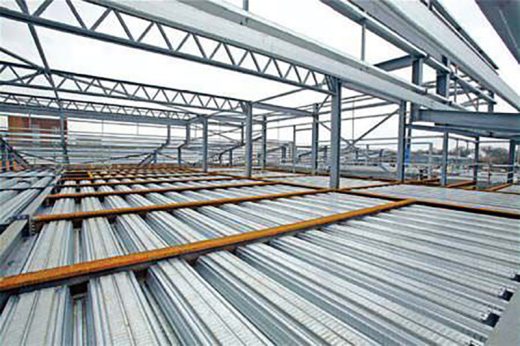
Fig4: Composite Structure
Courtesy: voltagreens.com
Composite structures refer to engineered materials composed of two or more constituent materials with different properties. These constituent materials, known as the matrix and reinforcement, work together to create a composite material that exhibits enhanced mechanical, thermal, or electrical properties compared to its components. The matrix material acts as a binder or medium that holds the reinforcement material in place and transfers load between the reinforcement fibers or particles. It can be a polymer, metal, ceramic, or a combination. The choice of matrix material depends on the desired properties and the application of the composite structure.
The reinforcement material gives the composite strength, stiffness, and other qualities. It’s usually fibers, particles, or sheets. Nanoparticles, carbon, glass, and aramid fibers are reinforcing materials. The composite structure is formed by embedding reinforcement material in the matrix. Composite constructions’ matrix and reinforcing materials can be tailored to fulfill design requirements. Composite structures offer design flexibility, corrosion resistance, fatigue resistance, and a high strength-to-weight ratio. They can have great tensile strength, stiffness, and impact resistance while lightweight.
5. Cables and Arches Structures:
Cables and arches are two distinct structural elements commonly used in civil engineering and architecture to stabilize and support various structures. While cables are slender, tensioned elements primarily used for suspension purposes, arches are curved, compression-based components that distribute loads efficiently. Cables are flexible, tensioned members often made of steel or high-strength materials. They are frequently used in structures requiring large spans or suspensions, such as bridges and roofs. Cables can resist tensile forces by efficiently transferring them along their length. They are characterized by their ability to withstand high loads while maintaining their slender form. Tensioned cables are typically anchored at both ends and carry the load by converting it into axial tension forces. Common applications of cables include Suspension Bridges, Cable-Stayed Bridges, and Tensile Structures,
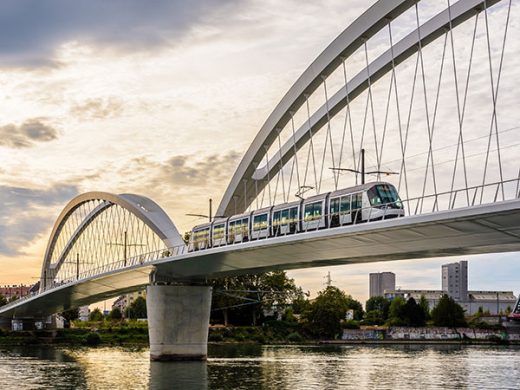
Fig5: Cables and Arches Structure
Courtesy: pfeifer-structures.com
Arches efficiently distribute stresses by turning vertical loads into horizontal thrust transmitted down the curve to the supporting foundations or abutments. Arches are strong, stable, and attractive. Bridges, buildings, and tunnels use arches. Cables and arches have distinct structural advantages and have been used in many landmark constructions. They allow engineers and architects to develop impressive and practical bridges, buildings, and other architectural projects.
6. Mass Structure:

Fig6: Mass Structure
Courtesy: pfeifer-structures.com
“Mass structure” typically refers to a building or structure primarily composed of solid and heavy materials, such as stone, concrete, or masonry. Mass structures are designed to rely on their weight and the materials’ strength rather than heavily on structural elements such as beams, columns, or frames. Mass structures are known for their stability, durability, and resistance to external forces such as wind, earthquakes, and temperature fluctuations. Heavy materials provide inherent strength and stability, making mass structures suitable for large-scale buildings, such as monuments, cathedrals, and historic structures.
The design and construction of mass structures often involve thick walls, deep foundations, and robust load-bearing elements to support the structure’s weight. The materials’ mass helps absorb and distribute loads, minimizing the need for additional structural supports. Examples of mass structures include pyramids, medieval castles, and ancient fortifications.
7. Pre-Engineered Structure:
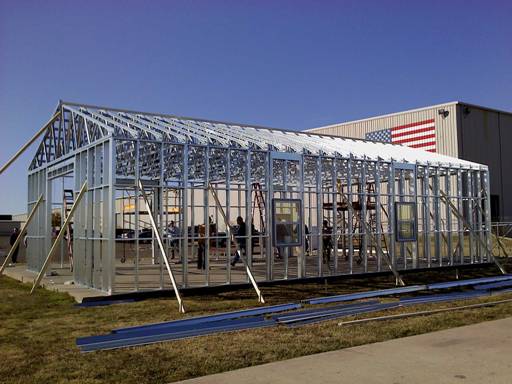
Fig7: Pre-Engineered Structure
Courtesy: constrofacilitator.com
Pre-engineered structures are made off-site and constructed on-site. Before being shipped to the construction site, these structures are designed, engineered, and built at a factory. Standardized designs and components define pre-engineered structures. It means that columns, beams, roof panels, wall panels, and other structural components are pre-designed and manufactured to industry standards. Steel, concrete, or wood are usually used for the components.
Pre-engineered structures require numerous processes. Building purpose, size, layout, and load requirements determine the design and specifications. After the design, manufacturing begins. Factory machinery makes structural components from steel or other materials. These components are supplied to the construction site and bolted or welded. Pre-engineered buildings save time and money. The components are pre-designed and fabricated off-site, making construction faster than traditional methods. It saves time and money.
8. Tension Structure:
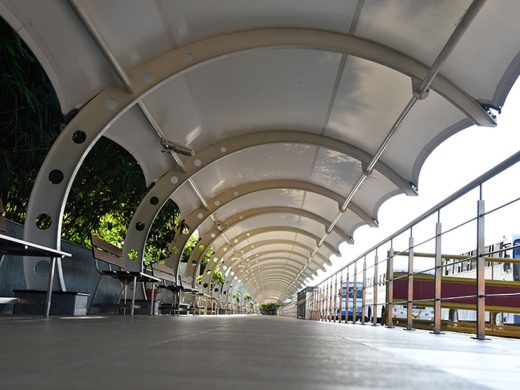
Fig7: Tension Structure
Courtesy: shadecoindia.com
A tension structure is an architectural or engineering design that relies on tensioned elements to create a stable and self-supporting structure. Unlike traditional structures that use compression or bending to support their load, tension structures utilize tensioned cables, membranes, or other flexible materials to distribute forces and maintain their shape. Tension structures are known for their lightweight and visually striking designs. They often feature large spans and open spaces with minimal use of columns or other traditional support elements. The tensioned components of these structures are typically made from materials such as steel cables, synthetic fabrics, or membranes capable of withstanding high tensile forces.
Tension structures are popular due to their aesthetic appeal, versatility, and efficient use of materials. They can provide large covered spaces with minimal obstruction, allowing for flexibility in design and functionality. Additionally, tension structures often have a relatively quick installation process compared to traditional structures, making them suitable for temporary or semi-permanent applications.
Conclusion:
Overall, the structure in construction refers to the framework or arrangement of elements that provide support, stability, and durability to a building or any engineered construction, ensuring it can withstand various forces and loads it may encounter over its lifespan. Knowing the size of the building is important because it will help you plan for the tools you want or need to use. The bigger a building is, the more restrictions there are on how much weight it can hold.
References:
1. Panchal, M. (2021, July 27). Types Of Structure In Civil Engineering. PIGSO Learning. https://pigsolearning.com/civil-engineering/types-of-structure-in-civil-engineering
2. Desk, H. N. (2023, March 2). Structure Design: Basic, Types, Design and Importance. Housing News. https://housing.com/news/structure-design-principles-types-requirements-and-importance/
3. Sawant, H., & Chinurkar, K. (2022, February 19). Types Of Structural Systems: Why Are Structural Systems Important In Buildings? | The Design Gesture. The Design Gesture. https://thedesigngesture.com/structural-systems/
4. Iqbal, S. (2022, March 21). Types of Building Structure in Civil Engineering with images – Definecivil. Definecivil. https://definecivil.com/types-of-building-structure-in-civil-engineering-with-images/
5. Types of Structural systems – Constroquick.com. (2021, February 24). Constroquick.com. https://constroquicks.com/types-of-structural-systems/
6. Types of Structure – Mo Civil Engineering. (2020, October 23). Mo Civil Engineering. https://mocivilengineering.com/types-of-structure/
If you have a query, you can ask a question here.


